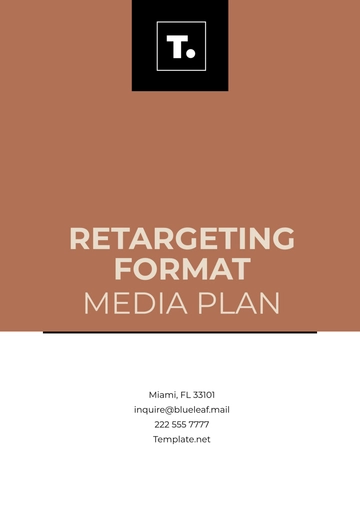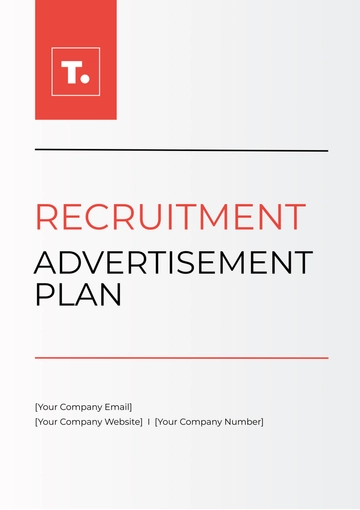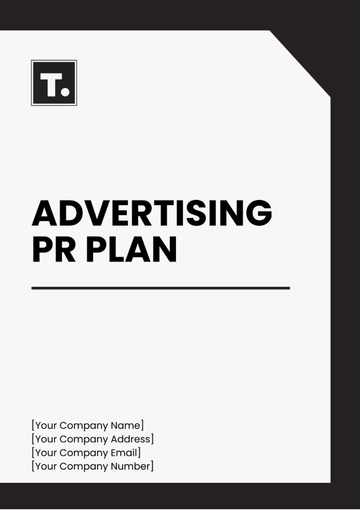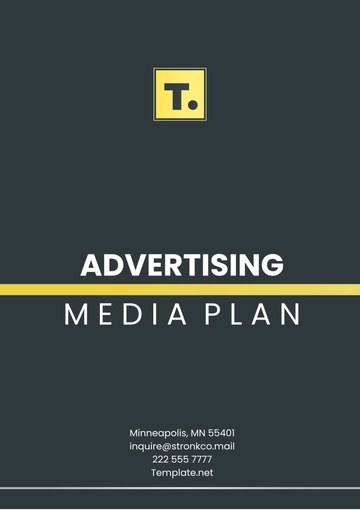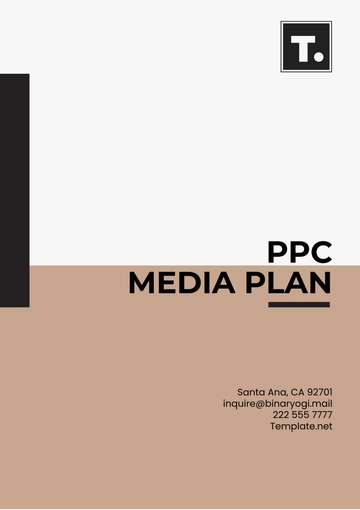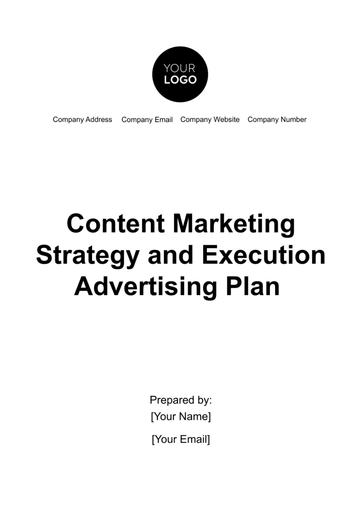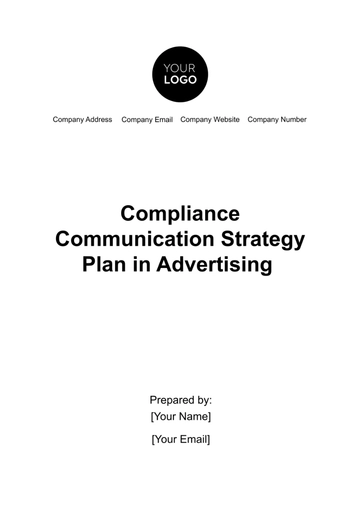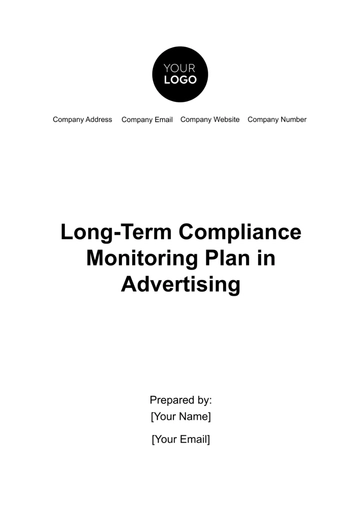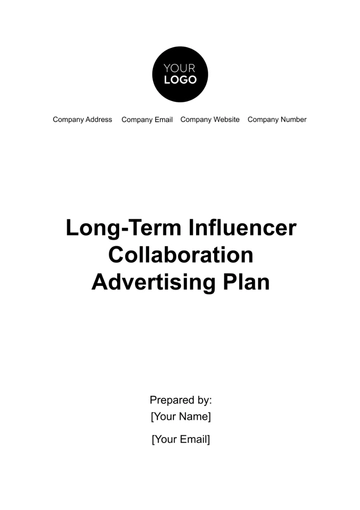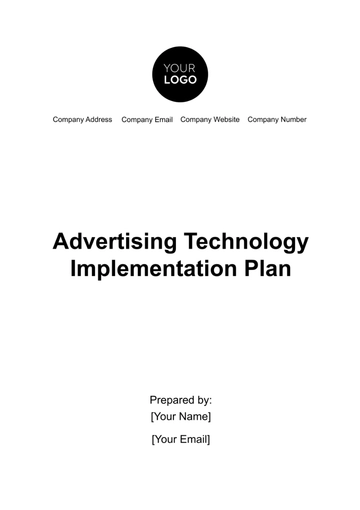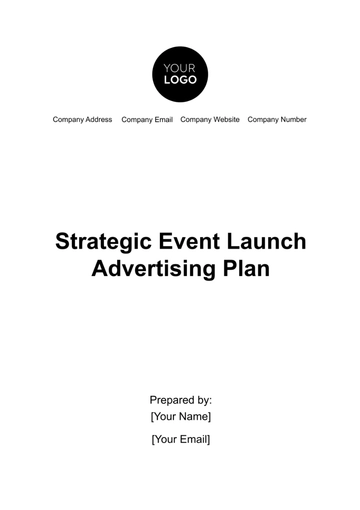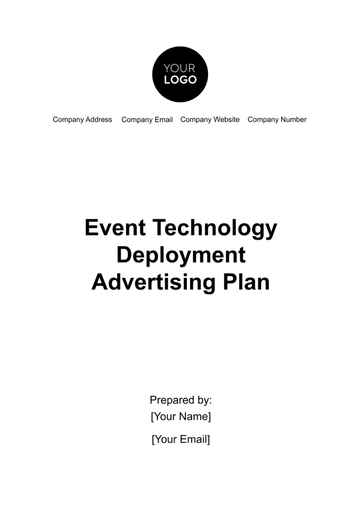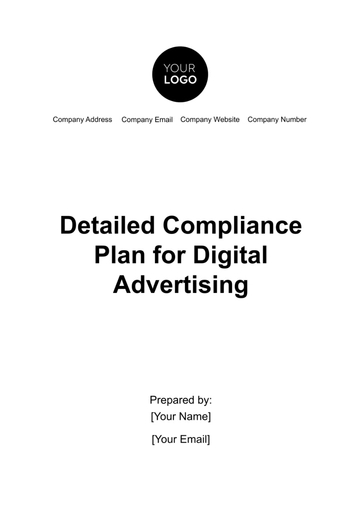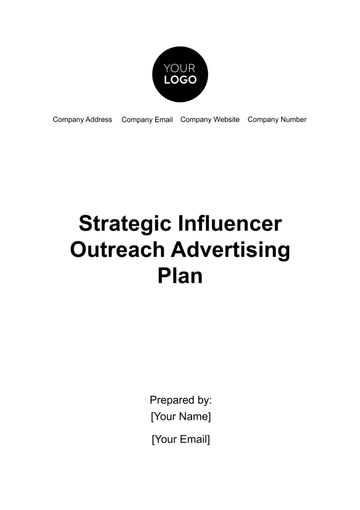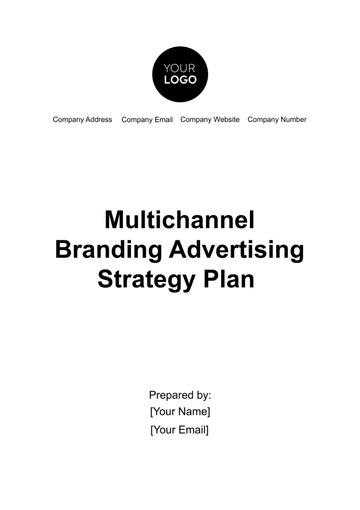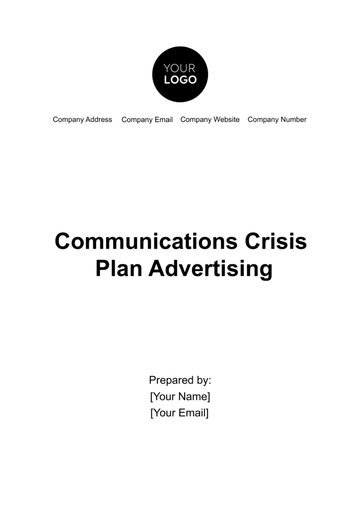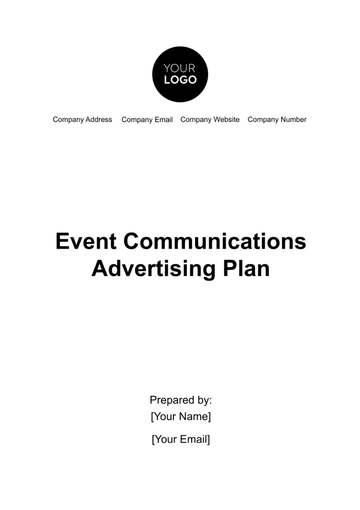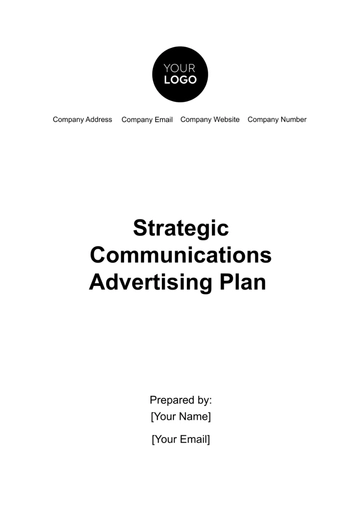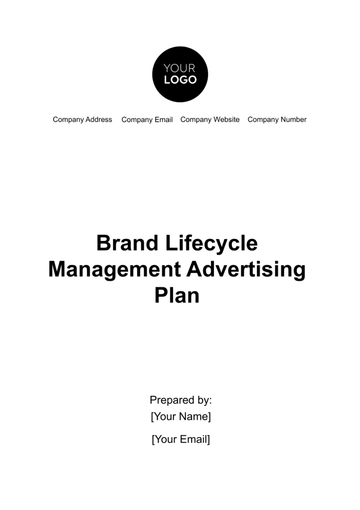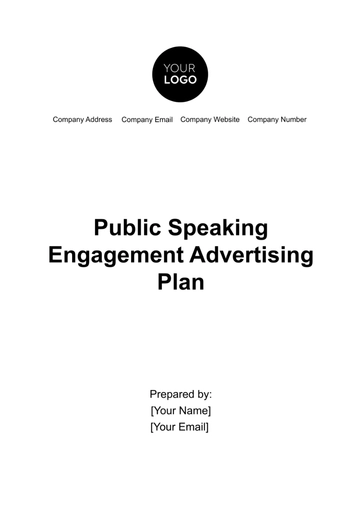Free Advertising Multichannel Digital Media Plan
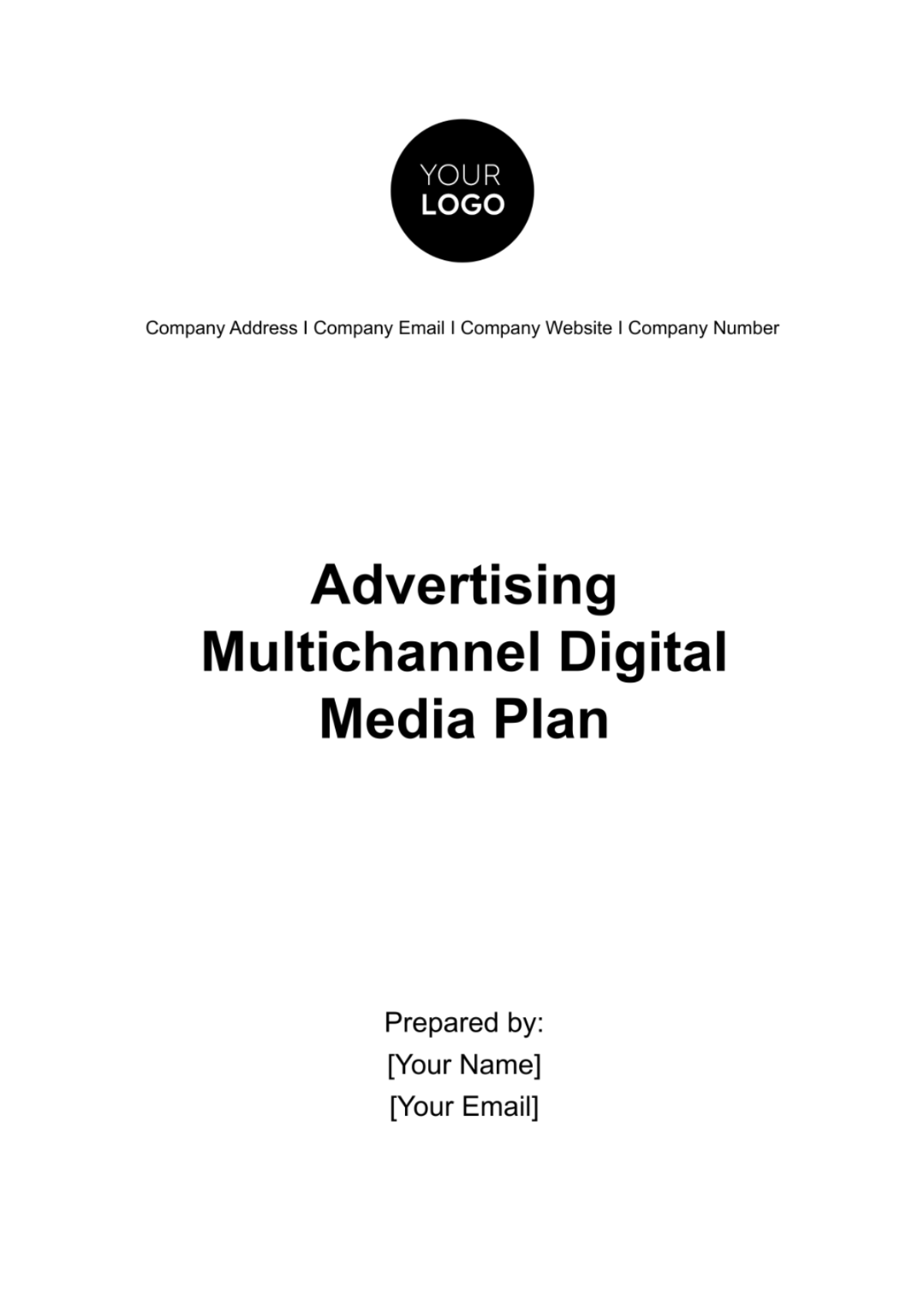
I. Executive Summary
A. Overview of the Multichannel Digital Media Plan
This Multichannel Digital Media Plan represents a strategic roadmap for [Your Company Name]'s advertising efforts in the digital landscape. With the ever-increasing importance of online presence, this plan outlines how we intend to harness various digital channels to maximize brand visibility, engage our target audience, and drive meaningful results. It encapsulates our commitment to staying at the forefront of digital advertising trends and technologies.
B. Key Objectives
Our primary objectives for this campaign are as follows:
Increase Brand Visibility and Awareness
We aim to enhance our brand's recognition and recall among our target audience by leveraging multiple digital channels effectively.
Drive Traffic to [Your Company Website]
Our goal is to boost website traffic significantly, leading to higher engagement and conversions.
Generate Leads and Conversions
We will focus on converting website visitors into leads and ultimately into paying customers.
II. Market Analysis
A. Market Segmentation
Our market analysis has led to the segmentation of our target audience into three distinct groups:
Young Professionals: Individuals aged 25-34 who are tech-savvy and value convenience.
Parents and Families: Families with children, seeking value and quality.
Tech Enthusiasts: Technology enthusiasts of all ages who are early adopters of new products.
B. Competitor Analysis
We have conducted an in-depth analysis of our competitors, including Competitor 1, Competitor 2, and Competitor 3. Through this analysis, we have identified their strengths and weaknesses, allowing us to capitalize on untapped opportunities in the digital advertising landscape.
Competitor | Strengths | Weaknesses | Opportunities | Threats |
|---|---|---|---|---|
Competitor 1 | Established brand presence | Limited digital advertising initiatives | Expanding into untapped demographics | Potential disruption from emerging rivals |
Diverse product offerings | Lack of personalized marketing strategies | Investing in innovative technologies | Shifting consumer preferences | |
Competitor 2 | Strong social media engagement | Narrow target audience | Diversifying advertising channels | Adapting to changing algorithms |
High-quality content production | Limited reach in certain demographics | Leveraging user-generated content | Increased competition in niche markets | |
Competitor 3 | Technologically advanced platforms | Limited offline presence | Expanding into international markets | Regulatory changes in digital landscape |
Robust customer loyalty programs | Lack of agility in campaign adjustments | Investing in AI-driven personalization | Economic downturn affecting ad budgets |
C. Target Audience Profile
Our target audience is defined by the following characteristics:
Age: Primarily 25-44 years old.
Interests: Technology, convenience, value.
Demographics: Predominantly urban, with disposable income.
Online Behavior: Active social media users, frequent online shoppers.
III. Multichannel Strategy
A. Channel Selection and Justification
Our multichannel strategy includes the following key channels:
Social Media Advertising (Facebook and Instagram): We chose these platforms due to their extensive user base and advanced targeting capabilities, allowing us to reach our diverse audience effectively.
Search Engine Marketing (SEM - Google Ads): SEM provides immediate visibility to users actively searching for our products or services, making it an essential channel.
Display Advertising (Google Display Network): Display ads will reinforce our brand and messaging on popular websites and apps.
Email Marketing (Mailchimp): Email marketing will enable personalized communication with our audience, nurturing leads and driving conversions.
Content Marketing (Blog Posts and Infographics): Content marketing will establish us as an industry authority and attract organic traffic.
B. Content Strategy
Our content strategy is geared towards delivering value to our audience:
Social Media: Engaging visuals, informative posts, and promotions.
SEM: Highly relevant ad copy and landing pages.
Display Advertising: Visually appealing creatives that reinforce our brand.
Email Marketing: Personalized emails with useful content and offers.
Content Marketing: High-quality blog posts and infographics.
C. Messaging and Branding Guidelines
Our messaging will revolve around the themes of innovation, value, and customer-centricity. We aim to create a consistent brand identity across all channels, ensuring that our audience recognizes and resonates with our messaging.
IV. Campaign Planning
A. Campaign Goals
Our campaign goals are as follows:
Increase Website Traffic by 30%: We aim to boost website visits by 30% compared to the previous year, primarily through organic and paid search.
Achieve a Click-Through Rate (CTR) of 8%: Our SEM and display ads are expected to achieve a CTR of 8% or higher.
Generate 500 Leads per Month: We target a monthly lead generation of 500, with a focus on quality leads that have a higher likelihood of conversion.
B. Key Performance Indicators (KPIs)
We will measure the success of our campaign using the following KPIs:
Website Traffic: Monitored through Google Analytics, we will track the number of sessions, page views, and average session duration.
CTR: Measured for SEM and display ads on Google Ads.
Conversion Rate: Calculated as the percentage of visitors who take desired actions on our website.
Lead Generation: Monitored through lead capture forms on our website.
C. Campaign Timeline
Our campaign will run for a duration of [6 months], starting from [January 1, 2050], and concluding on [June 30, 2050]. The timeline is as follows:
Month | Activities |
|---|---|
January | Campaign Launch, Content Creation |
February | SEM Optimization, Display Ad Rollout |
March | Social Media Advertising Intensification |
April | Email Marketing Campaigns, Content Publishing |
May | A/B Testing and Optimization |
June | Final Performance Analysis and Reporting |
V. Budget Allocation
Our total campaign budget is set at $500,000, distributed among the selected channels as follows:
Channel | Budget Allocation |
|---|---|
Social Media Advertising | $150,000 |
SEM (Google Ads) | $120,000 |
Display Advertising | $80,000 |
Email Marketing | $80,000 |
Content Marketing | $70,000 |
Miscellaneous Expenses | $5,000 |
Social Media Advertising: This channel receives a substantial budget due to its extensive reach and the importance of brand visibility on platforms like Facebook and Instagram.
SEM (Google Ads): SEM ensures immediate visibility to potential customers actively searching for our products or services.
Display Advertising: Display ads play a crucial role in reinforcing brand messaging; hence, a notable budget allocation.
Email Marketing: Email campaigns require investment in content creation, list management, and automation tools.
Content Marketing: High-quality content production is vital for SEO and attracting organic traffic.
VI. Channel Details
A. Social Media Advertising
Platform Selection: Facebook and Instagram
Ad Types: Sponsored Posts, Stories
Target Audience: Young Professionals (25-34), Parents and Families, Tech Enthusiasts
Ad Spend: $150,000
B. Search Engine Marketing (SEM)
Keywords Research: Extensive keyword research using tools like Google Keyword Planner.
Ad Copy and Landing Pages: Ad copies optimized for high relevance, and landing pages designed for conversion.
Ad Spend: $120,000
C. Display Advertising
Ad Networks: Google Display Network
Ad Formats: Banner, Video
Ad Spend: $80,000
D. Email Marketing
Email List Segmentation: Segmented based on user behavior, demographics, and engagement.
Content Strategy: Personalized content for each segment.
Email Service Provider: Mailchimp
Email Budget: $80,000
E. Content Marketing
Blog Posts: 20 high-quality blog posts
Infographics: 10 engaging infographics
Guest Posts: 5 guest posts on industry-leading websites
Content Creation Budget: $70,000
VII. Measurement and Reporting
A. Tracking Tools
We will utilize a combination of tracking tools and analytics platforms to monitor and measure the performance of our digital media campaign:
Google Analytics: This comprehensive analytics tool will provide detailed insights into website traffic, user behavior, and conversion data. It will help us track the effectiveness of our overall campaign in terms of traffic and user engagement.
Google Ads Metrics: For SEM and display advertising, we will closely monitor metrics such as CTR, quality score, and ad position within the Google Ads platform. This will allow us to optimize ad performance and keyword targeting.
Email Marketing Analytics: Our email marketing efforts will be tracked using Mailchimp's analytics, which will provide data on open rates, click-through rates, and conversion rates for each email campaign.
B. Reporting
We will generate reports on a monthly basis to assess the progress and performance of our digital media campaign. These reports will be shared with the internal team and stakeholders. Each report will include:
A summary of key performance indicators (KPIs).
An analysis of the previous month's data.
Insights and recommendations for optimization.
VIII. Optimization
A. Continuous Monitoring
Throughout the campaign duration, we will maintain constant vigilance over its performance. This includes daily monitoring of ad campaigns, website analytics, and email marketing metrics. We will promptly address any issues that may arise, such as ad budget overspending or underperforming keywords.
B. A/B Testing
To maximize the effectiveness of our digital media campaign, we will conduct A/B testing on various elements, including ad creatives, landing page designs, and email subject lines. This iterative testing process will help us identify what resonates best with our audience and make data-driven improvements.
C. Budget Reallocation Based on Performance
Our approach to budget allocation will be flexible. If a particular channel or campaign is outperforming others, we will consider reallocating budget resources to capitalize on the opportunity. Conversely, if a channel is underperforming, we will adjust the budget accordingly to ensure optimal resource allocation.
IX. Risk Management
A. Identification of Potential Risks
Our risk management strategy involves identifying and proactively addressing potential challenges and setbacks. Some of the key risks we have identified include:
Ad Budget Overspending: There is a risk that ad campaigns may exceed their allocated budgets, leading to unexpected costs.
Low Conversion Rates: Achieving high traffic but low conversion rates could impact the overall success of the campaign.
Ad Fatigue: Overexposure of ads to the same audience may result in ad fatigue and decreased engagement.
B. Mitigation Strategies
To mitigate these risks, we have put the following strategies in place:
Budget Monitoring: We will closely monitor ad budgets daily to prevent overspending. Automated budget controls will be implemented where applicable.
Conversion Rate Optimization: We will continuously optimize landing pages and ad copy to improve conversion rates.
Ad Rotation: Ad fatigue will be minimized through regular ad creative updates and audience segmentation.
XI. Conclusion and Next Steps
A. Key Takeaways
In summary, this Advertising Multichannel Digital Media Plan is a comprehensive roadmap designed to achieve our marketing objectives through a strategically organized multichannel approach. Key takeaways from this plan include:
Clear Objectives: Our primary objectives include increasing brand visibility, driving website traffic, and generating quality leads.
Target Audience: We have identified and segmented our target audience into distinct personas to tailor our messaging effectively.
Multichannel Strategy: Our chosen channels, such as social media advertising, SEM, display advertising, email marketing, and content marketing, have been carefully selected to reach our diverse audience.
Budget Allocation: The budget allocation has been thoughtfully distributed among these channels to maximize reach and effectiveness.
KPIs and Reporting: We will monitor performance through KPIs, generating monthly reports for analysis and optimization.
Risk Management: Potential risks have been identified, and strategies are in place to mitigate them.
B. Next Steps
The successful execution of this digital media campaign hinges on the following essential next steps:
Campaign Launch: Initiate the campaign according to the defined timeline, ensuring all creatives, content, and advertisements are live.
Continuous Monitoring: Implement daily monitoring of ad campaigns, website analytics, and email marketing metrics.
Reporting and Analysis: Generate monthly reports, detailing the performance of each channel and campaign.
Optimization: Conduct A/B testing on ad creatives, landing pages, and email subject lines to refine our approach continually.
Mitigating Risks: Proactively address potential challenges, such as budget overspending or low conversion rates, as outlined in our risk management strategy.
- 100% Customizable, free editor
- Access 1 Million+ Templates, photo’s & graphics
- Download or share as a template
- Click and replace photos, graphics, text, backgrounds
- Resize, crop, AI write & more
- Access advanced editor
Harness the power of diversity with the Advertising Multichannel Digital Media Plan Template from Template.net. This template, editable in our AI Editor Tool, helps you craft a comprehensive strategy for deploying advertising across multiple digital platforms, maximizing reach and engagement. Create an effective multichannel media plan with this customizable template.
You may also like
- Finance Plan
- Construction Plan
- Sales Plan
- Development Plan
- Career Plan
- Budget Plan
- HR Plan
- Education Plan
- Transition Plan
- Work Plan
- Training Plan
- Communication Plan
- Operation Plan
- Health And Safety Plan
- Strategy Plan
- Professional Development Plan
- Advertising Plan
- Risk Management Plan
- Restaurant Plan
- School Plan
- Nursing Home Patient Care Plan
- Nursing Care Plan
- Plan Event
- Startup Plan
- Social Media Plan
- Staffing Plan
- Annual Plan
- Content Plan
- Payment Plan
- Implementation Plan
- Hotel Plan
- Workout Plan
- Accounting Plan
- Campaign Plan
- Essay Plan
- 30 60 90 Day Plan
- Research Plan
- Recruitment Plan
- 90 Day Plan
- Quarterly Plan
- Emergency Plan
- 5 Year Plan
- Gym Plan
- Personal Plan
- IT and Software Plan
- Treatment Plan
- Real Estate Plan
- Law Firm Plan
- Healthcare Plan
- Improvement Plan
- Media Plan
- 5 Year Business Plan
- Learning Plan
- Marketing Campaign Plan
- Travel Agency Plan
- Cleaning Services Plan
- Interior Design Plan
- Performance Plan
- PR Plan
- Birth Plan
- Life Plan
- SEO Plan
- Disaster Recovery Plan
- Continuity Plan
- Launch Plan
- Legal Plan
- Behavior Plan
- Performance Improvement Plan
- Salon Plan
- Security Plan
- Security Management Plan
- Employee Development Plan
- Quality Plan
- Service Improvement Plan
- Growth Plan
- Incident Response Plan
- Basketball Plan
- Emergency Action Plan
- Product Launch Plan
- Spa Plan
- Employee Training Plan
- Data Analysis Plan
- Employee Action Plan
- Territory Plan
- Audit Plan
- Classroom Plan
- Activity Plan
- Parenting Plan
- Care Plan
- Project Execution Plan
- Exercise Plan
- Internship Plan
- Software Development Plan
- Continuous Improvement Plan
- Leave Plan
- 90 Day Sales Plan
- Advertising Agency Plan
- Employee Transition Plan
- Smart Action Plan
- Workplace Safety Plan
- Behavior Change Plan
- Contingency Plan
- Continuity of Operations Plan
- Health Plan
- Quality Control Plan
- Self Plan
- Sports Development Plan
- Change Management Plan
- Ecommerce Plan
- Personal Financial Plan
- Process Improvement Plan
- 30-60-90 Day Sales Plan
- Crisis Management Plan
- Engagement Plan
- Execution Plan
- Pandemic Plan
- Quality Assurance Plan
- Service Continuity Plan
- Agile Project Plan
- Fundraising Plan
- Job Transition Plan
- Asset Maintenance Plan
- Maintenance Plan
- Software Test Plan
- Staff Training and Development Plan
- 3 Year Plan
- Brand Activation Plan
- Release Plan
- Resource Plan
- Risk Mitigation Plan
- Teacher Plan
- 30 60 90 Day Plan for New Manager
- Food Safety Plan
- Food Truck Plan
- Hiring Plan
- Quality Management Plan
- Wellness Plan
- Behavior Intervention Plan
- Bonus Plan
- Investment Plan
- Maternity Leave Plan
- Pandemic Response Plan
- Succession Planning
- Coaching Plan
- Configuration Management Plan
- Remote Work Plan
- Self Care Plan
- Teaching Plan
- 100-Day Plan
- HACCP Plan
- Student Plan
- Sustainability Plan
- 30 60 90 Day Plan for Interview
- Access Plan
- Site Specific Safety Plan

